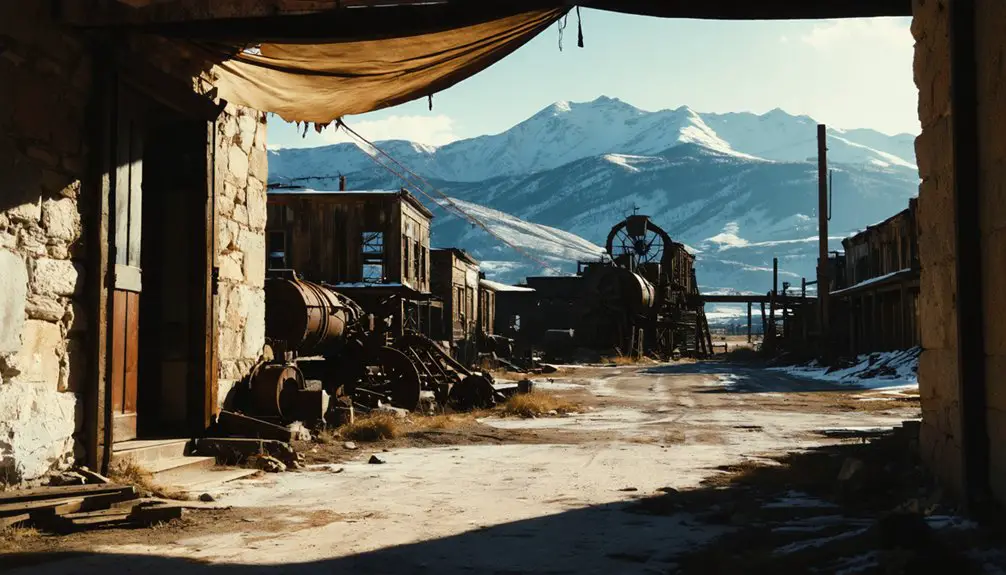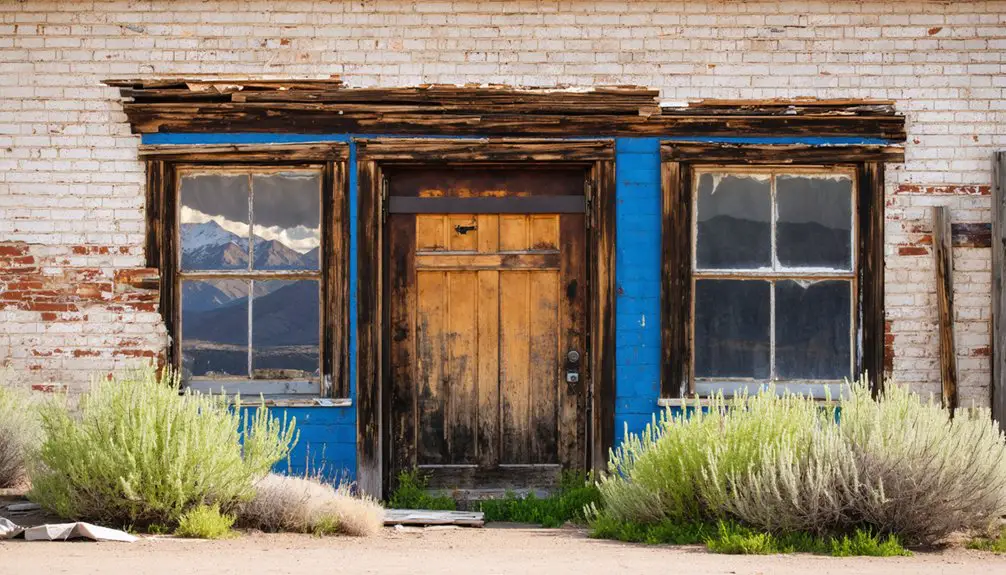You’ll discover Mercur in Utah’s Oquirrh Mountains, where a once-bustling gold mining boomtown of 5,000 residents now stands silent. The town flourished in the 1890s after introducing innovative cyanide extraction processes, complete with the impressive Golden Gate Mill processing 1,000 tons of ore daily. Today, only the historic cemetery remains, featuring 100 graves with a single legible headstone from 1898. The site’s rich history holds countless untold stories beneath its weathered surface.
Key Takeaways
- Mercur was once Utah’s largest gold-producing town, peaking at 6,000 residents before declining to a complete ghost town.
- The town thrived from 1890-1913 due to innovative cyanide extraction processes before economic decline led to its abandonment.
- A devastating fire in 1902 marked the beginning of Mercur’s decline, though mining operations continued until resources were exhausted.
- The site features a historic cemetery with 100 graves, including 40 marked graves and one remaining legible headstone from 1898.
- Located in the Oquirrh Mountains, the ghost town site is accessible via a 25-minute drive from Tooele and steep hike.
The Rise of Utah’s Golden Boomtown
While early mineral prospectors initially focused on placer gold and silver deposits in the Mercur area during the 1870s, it wasn’t until the revolutionary cyanide extraction process in 1890 that the region’s true potential emerged.
You can trace Mercur’s gold rush transformation from a nearly deserted settlement into Utah’s premier mining boomtown. By 1895, the population exploded to over 5,000, establishing Mercur as one of Utah’s largest cities.
The mining legacy gained momentum with the completion of the Salt Lake and Mercur Railroad in 1895, followed by the construction of the Golden Gate Mill in 1898. This 500-ton capacity mill, powered by the country’s longest electrical transmission line from Provo, cemented Mercur’s position as a leading American gold production center. The successful mining operations yielded 2.5 million gold ounces from 1871 until the mine’s closure. Mining operations were later halted when the U.S. government ordered all gold mines to close in 1942 to conserve resources for World War II.
Mining Innovation and the Cyanide Revolution
Although early miners discovered gold in Mercur’s ore deposits during the 1880s, the microscopic nature of the gold particles initially prevented profitable extraction through traditional methods.
Everything changed in 1891 when Mercur became the first successful site in America to implement the revolutionary cyanide process.
You’ll find the turning point centered on the Golden Gate Mill, constructed in 1897. This massive facility, designed by Daniel C. Jackling, processed an impressive 1,000 tons of ore daily, showcasing unprecedented cyanide efficiency.
The mill’s success triggered widespread adoption of these new mining techniques across the district. Through constant experimentation, operators refined the process, introducing innovations like zinc shavings and slime plants to maximize gold recovery. To avoid confusion with similar mining sites, direct navigation links were established to distinguish Mercur’s pioneering achievements.
These technological breakthroughs transformed Mercur into a model for modern gold extraction worldwide. The town’s population grew to five thousand residents during its peak production years between 1890 and 1917.
Life in a Thriving Mountain Mining Community
As Mercur’s population swelled beyond 5,000 residents in the late 1890s, the remote mountain settlement transformed into one of Utah’s largest cities.
You’d find a vibrant social fabric woven from mining families, Italian immigrants, and workers in supporting trades, all maneuvering life 60 miles from Salt Lake City.
The town’s community dynamics centered around the steady rhythm of mine shifts, with workers returning to modest homes and gathering at the Opera House Saloon or local church.
You could catch brass band performances, read the latest *Mercur Miner* newspaper, or attend events that united the isolated population.
Modern amenities included electricity from a groundbreaking 50-mile transmission line, while essential services like the fire department and a high-capacity mountain road supported daily life in this thriving frontier settlement.
The Golden Gate Mill helped establish Mercur as a major gold processing center, driving the town’s rapid growth and prosperity.
The devastating 1902 fire that swept through the business district marked a turning point in the town’s fortunes.
The Italian Legacy and Cultural Heritage
Once Northern Italian immigrants began arriving in Mercur during the late 1800s, they quickly established the largest Italian settlement among Utah’s mining camps.
You’ll find their cultural influence woven throughout Mercur’s social fabric, particularly in the community celebrations that defined town life. The annual Columbus Day festivities featured vibrant parades and performances by the Mercur City Band, while the Catholic church, built in 1904, became their spiritual and cultural anchor.
Italian traditions flourished as immigrants created support networks for newcomers, helping them adapt while preserving their heritage. Despite the demanding work in the gold mines, these Northern Italian families fostered a dynamic community life that balanced hard labor with rich cultural practices, fundamentally shaping Mercur’s character during its golden age. Unlike their Southern Italian counterparts, these immigrants had experience with seasonal work abroad, making their adjustment to life in Utah’s mining industry smoother. The town’s population reached its peak of five thousand residents during this thriving period of cultural integration.
Power, Progress, and Infrastructure
While steam power initially drove Mercur’s mining operations, the town’s infrastructure evolved dramatically through technological breakthroughs and industrial investment.
You can trace this energy evolution from coal-fired boilers at the Golden Gate mill to later electrified equipment introduced by Getty and Barrick. The infrastructure legacy includes vanished railroads that once transported massive quantities of ore, and pioneering water management systems that tackled the region’s chronic scarcity.
The revolutionary cyanide process transformed Mercur’s mining capabilities in the 1890s, allowing profitable extraction from previously worthless ore. The town’s Salt Lake Railroad completed in 1896 marked a pivotal advancement in transportation infrastructure.
Decline of the Golden Dream
Despite Mercur’s technological advances and early prosperity, the town’s golden era drew to a close when ore deposits beneath Main Street pit became economically unfeasible by the mid-1990s.
You can trace the economic decline through multiple phases, starting with the first boom’s end in 1913 when the Golden Gate Mill closed. The workforce shrank dramatically from 250 to 103 workers in the final years, mirroring the earlier community displacement that saw the population plummet from 6,000 to just two residents.
Though technological innovations like the cyanide process and 1989 autoclave installation briefly revived operations, they couldn’t prevent the inevitable resource exhaustion.
Haunting Tales From the Oquirrh Mountains

Deep within the Oquirrh Mountains, Mercur’s abandoned grounds harbor dark echoes of its mining past.
Silent shadows of miners still linger among the crumbling ruins of Mercur, whispering tales through the mountain mist.
You’ll find the most concentrated reports of ghostly encounters at the historic cemetery, where primitive mining conditions and frequent accidents left many souls in tragic circumstances. The town’s multicultural fabric, including Italian and Chinese immigrants, has woven rich supernatural narratives into local lore. The cemetery contains roughly 100 unmarked graves, silently preserving the stories of those who lived and died in this once-bustling mining town.
The rugged terrain amplifies your chances of spectral sightings, as mountain winds create eerie acoustics through decaying structures and equipment.
You’ll notice how the remote location’s natural phenomena – from mysterious lights to unexplained mists – fuel persistent haunting tales. The site’s documented disasters, including the devastating 1902 fire, have left an indelible mark on this mountainside, where visitors still report unexplained phenomena among the quiet remnants of Mercur’s golden age.
What Remains: The Cemetery and Modern Access
Perched atop a steep hill in Utah’s Oquirrh Mountains, Mercur Cemetery stands as the last significant vestige of this once-bustling mining town.
You’ll find about 100 graves here, with 40 marked by rock ovals and limestone slabs, while 20 feature individual picket fences. Only Annie C. Jones’s headstone remains legibly carved from 1898.
Cemetery access requires a 25-minute drive from Tooele, followed by a challenging climb up narrow steps or a steep trail.
You won’t find modern facilities here – just a wooden sign and historical plaque marking this cultural landmark. When visiting, you’ll need to park at the base and trek upward.
The site’s weathered appearance and quiet solitude perfectly capture its ghost town heritage, though you’ll want to respect this sacred ground as both a historical site and final resting place.
Frequently Asked Questions
What Was the Average Temperature and Climate Like in Mercur?
You’ll experience significant temperature fluctuations, with winter lows reaching 20°F and summer highs hitting 80°F. The high-elevation climate brings seasonal variations marked by cold winters and semi-arid conditions.
Were There Any Famous Outlaws or Notable Crimes in Mercur?
You won’t find famous outlaw legends or significant crime history here – historical records focus on mining hardships and accidents rather than criminal exploits, with the 1902 fire being accidental, not criminal.
How Much Did Miners Typically Earn During Mercur’s Peak Years?
You’d have earned $3-5 daily as a basic miner, while skilled positions brought in $5-7 or more. Mining wages varied with economic impact factors like ore quality and market conditions.
What Happened to the Buildings and Equipment After the Town’s Abandonment?
By 1916, you’d find only one of the original abandoned structures still standing. Historical artifacts and equipment vanished gradually after the 1913 shutdown, with remaining buildings razed in the 1980s.
Did Any Original Mercur Residents or Their Descendants Return After 1930?
You won’t find evidence of original residents or their descendants returning to live there after 1930. While descendant visits may have occurred, historical records show no permanent resettlement in the abandoned town.
References
- https://www.loc.gov/item/sn85058273/
- https://worldofurbanlegends.com/mercur-cemetery-ghost-town/
- https://en.wikipedia.org/wiki/Mercur
- https://westernmininghistory.com/towns/utah/mercur/
- https://www.uen.org/utah_history_encyclopedia/m/MERCUR.shtml
- https://www.latimes.com/archives/la-xpm-1997-03-16-me-38796-story.html
- https://geology.utah.gov/map-pub/survey-notes/the-mercur-district-a-history-of-utahs-top-gold-camp/
- https://kids.kiddle.co/Mercur
- https://historytogo.utah.gov/italianita-utah/
- http://utahspresenthistory.blogspot.com/2011/05/mined-out-of-existence-ghost-town-two.html



